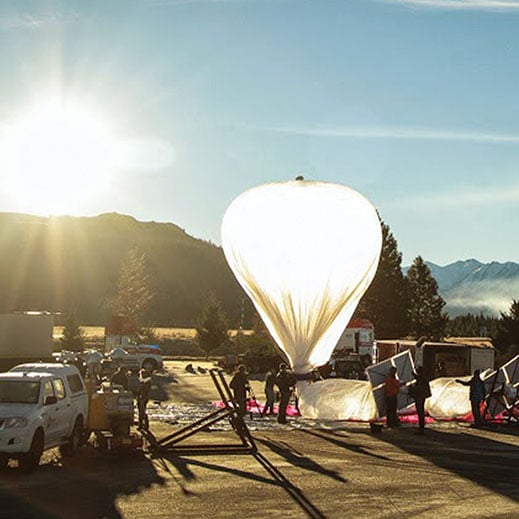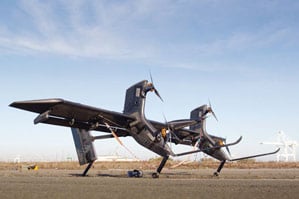Of the hundreds of MIT alumni employed at Google, at least 29 work in a secluded two-story building on the company’s campus in Mountain View, California.

The building is the home of Google X, the company’s top-secret research lab. For those inside, success is measured not in ad sales or clients but in “moon shots,” a term Google cofounder Sergey Brin uses to describe “a huge problem, a radical solution, and the breakthrough technology that might just make that solution possible.”
Moon shot number one is Google Glass, the result of more than 20 years of wearable-computing research. Much of that research originated at the MIT Media Lab, which hosted the first symposium on wearable computing in 1997.
Mary Lou Jepsen, SM ’89, was an early pioneer of wearable computing. Now leading the display division at Google X, Jepsen has called wearable computing an unstoppable force that will become addictive for consumers.
Glass is already proving a boon to surgeons, who can monitor a patient’s vital signs without taking their eyes off the task at hand. It may help stock traders, mechanics, or anyone who could benefit from integrating a virtual display into the real-world field of vision. Gartner estimates that Glass may save businesses $1 billion a year or more by eliminating time between tasks.

Jepsen and Media Lab classmate Thad Starner ’91, SM ’95, PhD ’99, who both helped develop Glass, became ambassadors for the product after its early-adopter program launched in 2012. But bringing wearables to the masses is only one of at least four major projects currently in high gear at Google X.
Mike Cassidy ’85, SM ’86, is leading Project Loon, a campaign to bring Internet access to developing countries. His chief technical lead is Rich DeVaul, SM ’99, PhD ’04, and their team includes James Morash ’01, MEng ’08; Keith Bonawitz ’02, MEng ’03, PhD ’08; Sameera Ponda ’04, SM ’08, PhD ’12; Edward Keyes ’05; Bradley Rhodes ’92, SM ’96, PhD ’00; and Baris Erkmen ’02, SM ’03, PhD ’08.
As Google X revealed in June 2013, Loon’s mission is to launch thousands of small hot-air balloons into the stratosphere, where they will circle the globe on wind currents and use solar power to relay Wi-Fi signals to receivers on homes in rural areas. The Loon team spent last summer in New Zealand, beta-testing the product over a remote island.
“Loon has required a combination of many interdisciplinary fields,” says Ponda, who studied aeronautical engineering. “We have to take into account the conditions of the stratosphere, electronics, the thermo balance, the wind … it helps to have a breadth of expertise in a lot of fields. That was what I got at MIT. My research was very much a cross of aero-astro, EECS, and other fields.”
But research in a lab is vastly different, Ponda says, from research at Google X. “On campus, you focus on your one area. I focused on algorithms in a lab,” she says. “Here, you have to implement your idea in real life, which involves attention to details you often don’t think of.”
The Loon team is in the process of assessing its results from New Zealand. If the researchers can perfect the balloon material and technology, the next test will send balloons around the 40th parallel south, offering Internet access to homes in Argentina, Brazil, Chile, South Africa, and Australia. The project could change millions of lives.

“I’ve found that ballooning science can be much harder than rocket science,” says DeVaul. “Everything about this project was insanely hard, but it’s something that could not have been done even five or 10 years ago. We’re got the right computing power now. In the next year or so, we’ll see some big announcements. I won’t say by 2020 the entire world will be covered, but so far we haven’t found any reason not to believe that.”
Beyond Glass and Loon, Google X teams, whose backgrounds range from design and engineering to public policy and the military, conceive of dozens of ideas each month and meet to test and vet them. Teams dismiss ideas that have failed in other environments, can’t be tested quickly, or simply violate the laws of physics. “Fast, productive failure” is their mantra.
Teams also get ideas from Solve for X, a website that invites contributors to submit and assess radical solutions to global problems. There, entrepreneurs and dreamers vote on whether various 3-D printers, surgical techniques, or immigration policies should be the focus of the next moon shot.
“The great news is that there are so many huge global problems out there—the problems are thick on the ground,” DeVaul says. “My big fear is that people will be afraid because they’re so big. But they’re not as big as ‘tracking’ your degree [requirements] at MIT. And we don’t want people saying ‘What’s Google X going to do next?’ but rather ‘What is the world going to do next?’”
One of the newest moon shots was originally conceived by the wind energy startup Makani Power, which Google X acquired in May and whose staff boasts at least seven MIT alumni: Ken Jensen ’03; Andrew Goessling ’12; Leo Casey ’85, SM ’84, ScD ’89; George Homsy, SM ’97, PhD ’04; Gregor Cadman ’06; Paula Echeverri ’04, SM ’06, PhD ’09; and Damon Vander Lind ’07.
In early 2013 the team, led by Lind, who is Makani’s chief engineer, tested a kite-plane that flies in loops to collect wind power through propeller-like turbines. When the wind is strong enough, the plane releases on a tether from a stationary telephone-pole-like perch. It catches the currents, rotating the turbine’s blades to drive a generator. Once the wind dies, the plane is reeled back to the perch. When and if this creation comes to market, Lind expects it to cost half as much as traditional wind turbines but produce power twice as reliably.
Empowering surgeons, educating the masses, reducing carbon emissions: these are targets for Google X. Its confidence in taking them on shows what can happen when a lab run like a startup is backed by a company worth more than $300 billion.
Keep Reading
Most Popular
Large language models can do jaw-dropping things. But nobody knows exactly why.
And that's a problem. Figuring it out is one of the biggest scientific puzzles of our time and a crucial step towards controlling more powerful future models.
How scientists traced a mysterious covid case back to six toilets
When wastewater surveillance turns into a hunt for a single infected individual, the ethics get tricky.
The problem with plug-in hybrids? Their drivers.
Plug-in hybrids are often sold as a transition to EVs, but new data from Europe shows we’re still underestimating the emissions they produce.
Stay connected
Get the latest updates from
MIT Technology Review
Discover special offers, top stories, upcoming events, and more.